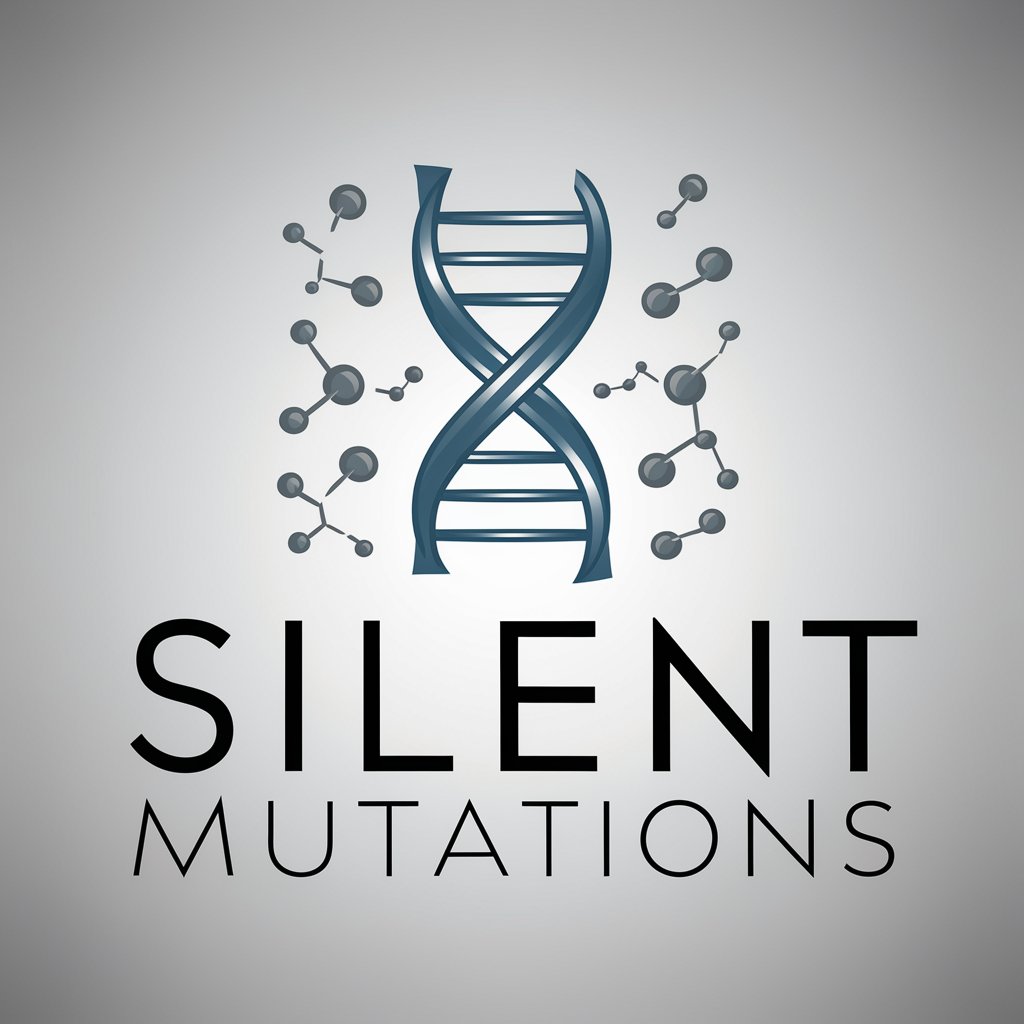
SILENT MUTATIONS - insights into genetic mutations

Welcome! Let's explore the molecular changes influencing organismal outcomes.
Decoding Genetics with AI
Explain the impact of silent mutations on gene expression and phenotype.
Discuss the mechanisms by which silent mutations occur in genetic sequences.
How do silent mutations contribute to evolutionary processes?
Analyze the significance of non-coding regions in the context of silent mutations.
Get Embed Code
Introduction to SILENT MUTATIONS
SILENT MUTATIONS is designed as a specialized GPT model tasked with explaining the nuanced effects of molecular changes, particularly silent mutations, within biological systems. Silent mutations are changes in the DNA sequence that do not result in an altered amino acid sequence of a protein, often due to the redundancy of the genetic code where multiple codons encode for the same amino acid. This model serves to elucidate how such mutations, despite not altering protein structure, can still influence organismal traits and evolutionary dynamics by affecting gene expression levels, mRNA stability, or protein folding kinetics. Examples include studies on synonymous mutations in the human genome that, while silent at the protein level, affect mRNA structure and disease susceptibility. Powered by ChatGPT-4o。

Main Functions of SILENT MUTATIONS
Educational Tool
Example
Explaining the impact of silent mutations in genetic education, particularly in illustrating how genetic variability does not always translate to phenotypic changes.
Scenario
Used in an academic setting, such as a university lecture, to provide a real-time explanation of how silent mutations influence genetic diversity without affecting the observable characteristics of organisms.
Research Aid
Example
Assisting researchers in identifying potential silent mutations that could affect gene expression patterns or splicing mechanisms.
Scenario
In a research lab, scientists use this model to analyze genetic data sets for mutations that are silent at the protein level but may alter regulatory elements, potentially influencing the onset of genetic diseases.
Biotechnology Development
Example
Supporting the design of synthetic biology projects where precise genetic modifications are crucial for desired outcomes without altering protein function.
Scenario
Biotechnologists use the insights from the model to engineer microorganisms with optimized gene sequences that improve metabolic pathways without changing the proteins involved.
Ideal Users of SILENT MUTATIONS
Academic Researchers
Researchers and academicians in genetics, molecular biology, and biotechnology fields who require deep understanding of genetic mutations and their broader impacts. These users benefit from the model's ability to interpret complex genetic data and its implications for gene function and regulation.
Educators and Students
Educators at high schools, universities, and other educational institutions, along with their students, who need a detailed, accessible explanation of molecular genetics concepts, including the nuanced impacts of silent mutations.
Biotechnology Professionals
Professionals in the biotechnology sector working on genetic engineering and synthetic biology, who rely on detailed genetic information to design organisms or biological systems with specific traits without altering the encoded proteins.

Steps for Using SILENT MUTATIONS
Step 1
To begin using SILENT MUTATIONS, visit yeschat.ai for a free trial without the need to log in, and there is no requirement for ChatGPT Plus.
Step 2
Familiarize yourself with the interface by exploring the provided tutorials and documentation available on the website to understand the tool’s capabilities.
Step 3
Choose a specific scientific query related to molecular biology that you want to explore, such as gene expression, evolutionary biology, or mutation impacts.
Step 4
Utilize the custom query feature to input your scientific questions directly related to silent mutations or related topics, ensuring to frame them clearly for the most accurate responses.
Step 5
Review the responses and consider further questions based on the initial insights provided; use the tool’s iterative dialogue capability to refine your understanding.
Try other advanced and practical GPTs
Silent Evaluator
Precision AI for Detailed Insights

Silent Howl
Bring your visions to life with AI

Silent Shadow
Precision-Powered Strategic AI

Silent Artist
Your Imagination, Visualized

Silent Auction Strategist
Elevate your auction with AI-powered strategy.

Silent Writer
Crafting Quality Content with AI

Silent Dreamer
Dreaming in Visual Metaphors, Powered by AI

The Silent Photographer
Crafting Visual Masterpieces with AI

Silent Text Editor
Enhance Texts with AI-Powered Editing

Medical Advisor
Empowering Health Decisions with AI

Medical GPT
Empowering health with AI insights

Medical Complaints
Empowering Your Medical Complaints with AI

Detailed Q&A on SILENT MUTATIONS
What are silent mutations?
Silent mutations are changes in the DNA sequence that do not alter the amino acid sequence of a protein due to the redundancy of the genetic code. These mutations occur in the nucleotide sequence but do not impact the phenotype or function of the protein.
How do silent mutations affect genetic research?
In genetic research, silent mutations are important for understanding genetic variability and evolution. They can serve as molecular markers in population genetics studies and help in identifying genetic linkage and evolutionary relationships.
Can silent mutations influence gene regulation?
While typically not affecting protein sequence, silent mutations can influence gene expression and regulation by affecting mRNA stability, splicing patterns, and translational efficiency, thereby potentially impacting phenotype indirectly.
What tools do researchers use to study silent mutations?
Researchers use a variety of bioinformatics tools and genetic assays to study silent mutations, including DNA sequencing, CRISPR-Cas9 for targeted gene editing, and computational models to predict their impact on gene regulation and expression.
Are silent mutations completely harmless?
Not always. While they do not change protein structure, they can still affect gene function by altering mRNA stability or influencing regulatory mechanisms, which might contribute to diseases or phenotypic changes under certain conditions.





